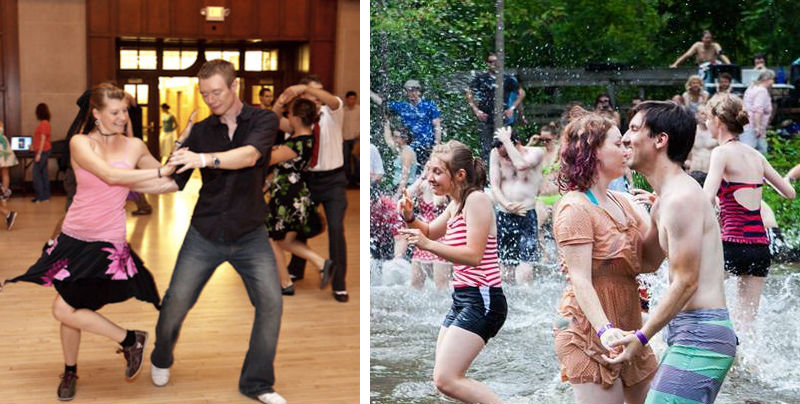Strike Up the Band and KissME: Swing dance fest jitterbugs back to Ann Arbor

Time to jump, jive, and wail at the 9th annual KissME (Keep It Simple and Swing) in Ann Arbor! The event brings "hundreds of people together for a weekend of music, fun, and dancing," says organizer Kenny Schabow.
While many folks enjoy jitterbugging about, they might not know swing dancing's storied history. When swing jazz took off in the 1920s, the style of dance we now call “swing” exploded right along with it. While the origins of jazz and swing dancing predate that era, its popularity began hitting the mainstream in the early decades of the 20th century. Dozens of styles were being flaunted in the dance halls with the most popular being the Lindy Hop, the Charleston, and the shag.
And just as the Rat Pack didn’t actually refer to itself as such, swing dancing wasn't called that until the late 1950s. In the early days, the term “jitterbug” signified dancing to high-energy swing-jazz music. Band leader Cab Calloway is said to have coined the phrase when he said the dancers looked like “a bunch of jitterbugs” because of their fast, bouncy movements. Whatever it was called, it found a home among dancers from Harlem to New Orleans.
Swing dancing's popularity waned a bit in the middle of last century only to see a resurgence in the 1990s, which found swing dance lessons and clubs springing up and at least one memorable Gap commercial. In and around Ann Arbor, people can swing dance on the regular thanks to groups like Swing Ann Arbor, Friday Night Swing, and the Ann Arbor Council for Traditional Music and Dance (AACTMAD). These groups sponsor Wednesday and Friday swing dances that feature beginner lessons for the first hour followed by open dancing.
Schabow, who is president of the Friday Night Swing group that attracts between 50-100 dancers every week, says KissME will include dancers who are new, experienced, and everything in between. He says, “Even brand new dancers can enjoy the music and experience and find someone to dance with.”
An impressive lineup of musicians will provide the music for all the KissME swingers. Locals bands including the K-Night Owls, James Dapogny’s Jazz Band, and Royal Garden Trio will join The Boilermaker Jazz Band from Pittsburgh and Alex Pangman & Her Alleycats out of Toronto. Friday night dances run from 8 pm until midnight and midnight until 5 am, both at Concourse Hall. Saturday offers an afternoon and evening dance at the Michigan Union Ballroom, followed by a late night dance at Concourse. An afternoon dance and barbecue will take place at Island Park on Sunday, followed by a return to Concourse Hall for a final evening dance and a blues afterparty.
A cornerstone of the weekend is the dance in the Huron River at Island Park. Schabow says: "Think of the song 'Wade in the Water' and then picture us splashing and dancing around in the shallow part of the river. We've become known for this tradition and people look forward to it every year!"
While there are many dances that make up the swing style, one of the best-known swing dances is the Lindy Hop. Using the eight-count structure of European dances along with improvisational movements, this dance form originated in African-American communities and got its name from the famous cross Atlantic flight by Charles Lindbergh. Orchestra leader TeRoy Williams recorded a song called "Lindbergh Hop," and the title became the name of a dance that was shortened to Lindy Hop by a Pittsburgh newspaper headline. Another newspaper predicted a short life for this dance -- a prediction that has most definitely not come true. Schabow says the Lindy Hop will likely be the most frequent swing dance at KissME and “you’ll see a lot of Charlestons and East Coast Swing dancing as well.”
The Charleston is forever associated with the "flappers" of the 1920s, mostly because of its uninhibited and energetic style. It is believed to have originated with African-American dances and became popular after appearing in the Broadway show called Runnin' Wild. A key part of the dance is "kicking up your heels" in an enthusiastic style.
The East Coast Swing (sometimes called the Jitterbug) was created in the Arthur Miller Studios and is based on the Lindy Hop. Unlike the eight count Lindy Hop and Charleston dances, it is a six count basic step. It was originally designed to be easier to teach than other swing dances (and also because some dance studios thought the Lindy Hop was a fad that would fade away quickly!).
If some of these terms don’t sound familiar and you wonder if you can even do the dances, relax! You will be welcomed and have a blast. Schabow promises, “It’s an all ages, all skill levels event. Anyone can come on out and find someone to dance with!”
Patti F. Smith is a special education teacher and writer who lives in Ann Arbor with her husband and cats.
The KissME weekend starts on Friday evening and runs until late on Sunday night. More information can be found on kissmeinannarbor.com and the Facebook event page.


































